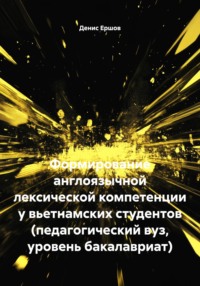
Полная версия
Английский язык. Полный курс
Согласно мнению М. Я. Блоха, в систему местоимений входят не только личные местоимения, но и местоименные наречия, а также глаголы-заменители, которые используются в тех же функциях. Также было установлено, что многозначные слова широкого значения образуют промежуточный слой между местоимениями и смысловыми словами. Эти многозначные слова тесно связаны с местоимениями благодаря своей способности замещать. Не нужно быть слишком умным, чтобы понять, что грамматическое число личных местоимений уникально и не похоже на количество обычных существительных. Обычно число существительного указывает на количество его референта: «один – больше, чем один» или, в более оппозиционной оценке, «множественное число – не множественное число». При этом качество референтов обычно не меняется с изменением числа (многочисленные исключения из этого правила не входят в нашу дискуссию).
Например, когда я говорю о нескольких пудреницах, я имею в виду ровно столько одинаковых предметов. Или, когда я упоминаю команду из одиннадцати футболистов, я имею в виду именно столько игроков в этой спортивной команде. Однако, когда речь заходит о личных местоимениях, ситуация меняется. И главная особенность этого различия заключается в том, что личное местоименное значение множественного числа неоднородно. Коммуникативные свойства предложений можно глубже понять, если обратиться к теории фактического членения предложения. Фактическое членение позволяет выразить информативное содержание высказывания с правильной градацией его частей в зависимости от их роли в контексте. Но любое высказывание формируется в рамках системы коммуникативных типов предложений.
Если мы сравним коммуникативную цель высказывания с его фактическим строением, то увидим, что каждое коммуникативное предложение обладает своими уникальными особенностями. Эти особенности особенно ярко проявляются в природе ремы – смыслового ядра высказывания. В строго декларативных предложениях мы непосредственно выражаем определённую мысль. Поэтому фактическое членение повествовательного предложения является наиболее полным и развёрнутым. Рема в таких предложениях занимает центральное место в высказывании. Это можно легко продемонстрировать с помощью вопроса-теста, который непосредственно раскрывает рематическую часть предложения. Например: «В следующее мгновение она узнала его». → «Что она сделала в следующее мгновение?»
Вопросительное местоимение «что» в этом примере ясно указывает на то, что часть « (узнал) его» является декларативной ремой, поскольку эта часть заключена в вопросительно-местоименную ссылку.. Другими словами, проверяемое высказывание с его законченным фактическим членением является единственным возможным ответом на заданный потенциальный вопрос. Говорящий произнёс это высказывание только для того, чтобы выразить, что его узнали. Ещё одним трансформационным тестом для определения декларативной ремы является логическое наложение. Логическая суперпозиция предполагает преобразование тестируемой конструкции в такую, в которой рема занимает позицию логически выделенного сказуемого. В качестве примера рассмотрим второе предложение из следующей последовательности: «И мне было очень не по себе. Меня одолевали всевозможные дурные предчувствия».
Логическое построение этого высказывания выглядит следующим образом: → «Меня одолевали всевозможные дурные предчувствия». Этот тест позволяет определить подлежащее высказывания «всевозможные предчувствия» как рему, так как именно эта часть высказывания оказывается в позиции сказуемого при суперпозиционном преобразовании. По мнению М.Я.. Блоха утверждает, что подобные диагностические процедуры помогают выявить многоуровневую структуру фактического членения в сложных синтаксических конструкциях. Например, в следующем сложноподчиненном предложении легко выделить три декларативные ремы на трех последовательных синтаксических уровнях, задав вопрос-тест с использованием ремы: «Я знал, что мистер Уэйд был очень взволнован тем, что он узнал» (У М. Я. Блоха в оригинале это звучит так: «I knew that Mr, Wade had been very excited by something that he had found out.»). Тест для первого синтаксического уровня: «Что я знал?» Тест для второго синтаксического уровня: «В каком состоянии был мистер Уэйд?» Тест на третий синтаксический уровень: «Что его взволновало?» (Или: «Чем он был взволнован?») В оригинале у М. Я. Блоха это выглядит так: «Test for the first syntactic layer: What did I know?
Test for the second syntactic layer: What state was Mr. Wade in?
Test for the third syntactic layer: What made him excited? (By what was he excited?)»
Строго императивное предложение, в отличие от строго декларативного, не предназначено для выражения какого-либо факта. Оно основано лишь на предположении, без его прямой формулировки. В императивных предложениях, побуждение к действию или его запрещение основывается на противопоставлении. Когда мы просим что-то сделать (утвердительное побуждение), мы предполагаем, что что-то не выполнено или не затрагивается желаемым действием. И наоборот, если мы просим не делать что-то (отрицательное побуждение), мы исходим из прямо противоположной предпосылки.
Fluffy: After reading all this information about the different parts of speech and how they are classified according to M. Ya. Bloch, I find it difficult to choose a point of view that would be most acceptable to all people learning English today.
Jasper: In order to better understand and absorb the material covered in the English theoretical grammar course, I would like to suggest that you do a small exercise.
Exercise 2. Answer the questions.
1.How many parts of speech are there in modern English, and what is M. Ya. Bloch’s approach to their classification? 2.What does it rely on? 3.Can data from cognitive linguistics be used to identify parts of speech?
Fluffy: Чтение – самый распространённый вид речевой деятельности в школе. Этому есть много причин. Ученики могут применять полученные умения чтения в повседневной жизни, и их формирование происходит быстрее и проще, чем умений говорения, письма и аудирования и сопутствующим им навыкам. В процессе обучения второму иностранному языку чтению часто уделяется особое внимание. Учителя используют проверенные методы обучения, которые показывают хорошие результаты. Это связано с тем, что в процессе чтения можно использовать уже имеющиеся знания и навыки. Особенности обучения чтению на втором иностранном языке заключаются в двух аспектах.
Первый – это обучение технике чтения, которое включает установление звукобуквенных соответствий и автоматизацию этих навыков. Этот процесс значительно ускоряется, если учащиеся уже владеют английским языком. Они знают латинский алфавит, и навыки чтения на английском языке облегчают им звукобуквенный анализ и синтез. Однако даже для старшеклассников может быть сложно самостоятельно анализировать звукобуквенные соответствия в английском языке из-за сложной системы буквосочетаний и необходимости использовать транскрипцию. Это может замедлить автоматизацию навыков, если у учащихся нет возможности дополнительно проработать сложные действия и операции. Кроме того, учащиеся сталкиваются с интерферирующим влиянием родного языка.
По этим причинам необходимо использовать специальные упражнения для отработки техники чтения на английском языке. При обучении технике чтения на английском языке как иностранном наиболее эффективным методом является имитация фраз и небольших текстов, записанных на плёнку. Это позволяет учащимся одновременно осваивать мелодику языка. Такая работа должна дополняться упражнениями на тренировку чтения особо сложных буквосочетаний. В процессе обучения чтению на иностранном языке важно сочетать отработку техники с коррекцией произношения соответствующих звуков. Ещё одна особенность обучения чтению на иностранном языке связана с повышением эффективности и интенсификацией процесса. В программных документах навыки, составляющие умение чтения, рассматриваются не только как цель обучения, но и как средство для развития речевых умений говорения и письма.
Письменный текст служит образцом, наблюдение за коммуникативной организацией которого помогает создавать собственные устные и письменные тексты. В процессе понимания текста читатель реконструирует его смысл. Каждый этап этой реконструкции требует мыслительной активности: узнавания, предвосхищения, проверки, сортировки и так далее. Интерпретативный потенциал чтения позволяет развивать умение создавать собственные тексты.
Это становится возможным благодаря пониманию особенностей организации «чужих» текстов. Чтобы обучение иностранному языку проходило более эффективно, методика формирования навыков чтения должна сочетать в себе два аспекта: * Обучение непосредственно чтению и пониманию текста. * Интерпретацию текста как продукта речевой коммуникации с целью создания подобных текстов в устной или письменной форме. Для развития речемыслительных навыков, образующих комбинированное умение чтения, мы предлагаем вам познакомиться с романом «Alligator» американской писательницы Shelley Katz. Книга была издана в 1977 году в Нью-Йорке издательством Dell и насчитывает 331 страницу.
Exercise 3. Answer the questions.
1.The methodology of developing reading skills: what does it consist of? 2. Do the systems of exercises for teaching reading techniques in the first and second foreign languages differ? 3.What reading skills should be developed when teaching students a second foreign language?4. How to build an effective system of exercises for teaching reading skills?
Fluffy: Let’s talk about alligators. Read and retell the following sentences borrowed from «Alligator» by Shelley Katz.
Prologue
They tell grim tales (мрачный, зловещий рассказ или сказка) of him all along the Florida Everglades (Национальный парк Эверглейдс). Blacks tell of a gator (крокодил) as big as an elephant that eats little children and attacks men in boats with the power and ferocity (свирепость) of a landlocked (закрытый) Moby Dick (Белый кит-произведение Германа Мелвилла). Whites in the small towns that border (граничить) the swamps (болота) have hunted him for years. They tried to kill him with axes (топорами), shotguns (карабинами, дробовиками, охотничьими ружьями), and hooks (багор, крюк).They say he has suffered (страдать, болеть) hours of agony from the wounds (раны) they have inflicted (нанесённые, причинённые); many times he has been close to death at their hands. В данном отрывке встречается множество стилистических приемов и выразительных средств, которые создают атмосферу страха и драматизируют рассказ о загадочном существе. Давайте рассмотрим основные из них:
Эпитеты: Слова «мрачные сказки» и «свирепость» задают эмоциональную окраску текста, подчеркивая зловещий характер рассказов о существе. Эпитеты усиливают шок от описания и акцентируют внимание на негативных эмоциях и ассоциациях.
Сравнение: Сравнение крокодила с «городским Мoby Dick» создает яркий и запоминающийся образ. Оно связывает ко всемирно известному стандарту силы и величия, который усиливает опасность крокодила, и привлекает внимание читателя на уровне культурного контекста, показывая масштаб и интенсивность угрозы.
Перечисление: Описание способов охоты на крокодила – «топорами, карабинами, дробовиками, баграми» – создает массивность усилий, прикладываемых к уничтожению существа. Перечисление усиливает представление о длительной борьбе человека с природой, а также раскрывает различные методы, применяемые людьми.
Персонификация страданий: Фраза «он страдает часы агонии» предполагает, что крокодил не просто жертва обстоятельств, но и воспринимаемое существо с интеллектуальным состоянием. Это углубляет эмоциональную связь читателя с крокодилом и добавляет ему человеческого аспекта.
Эмоциональная напряженность: Использование слов «агонья» и «близкое к смерти» создает атмосферу страха и жалости, подчеркивая хрупкость существа и его уязвимость, что заставляет читателя переживать за его судьбу.
Контраст между культурами: Упоминание о «черных» и «белых» рассказах подчеркивает различия в восприятии одной и той же фигуры в контексте разной культуры. Этот элемент создает ощущение многослойности рассказа и показывает, как мифология о крокодиле обретает разные формы в зависимости от культурных условий.
Визуальные образы: Описание крокодила как «огромного, как слон» создает впечатляющий и запоминающийся образ, который усиливает страх перед этим существом. Это помогает читателю визуализировать масштаб угрозы и мощь крокодила.
В целом, отрывок погружает читателя в атмосферу мифологии и ужасов, связанных с существом, представляющим собой как физическую, так и культурную угрозу. Эти выразительные средства и стилистические приемы работают на создание образа крокодила не только как животного, но и как символа страха, страдания и конфликта между человеком и природой.
Exercise 4. Working with text and dictionaries
1. Найдите в словаре верный перевод клише: " to kill him with axes». 2. Выберите в тексте верный перевод клише: «страдать, мучиться часами в агонии». 3. Найдите в словаре верный перевод клише: " close to death». 4. Приведите верный перевод клише: " attack with the power and ferocity». 5. Дайте верный перевод клише: " at their hands». Выберите в тексте пример, иллюстрирующий стилистический прием «антономасия», если таковой имеется. Объясните Ваше мнение.6. Выберите пример, иллюстрирующий стилистический прием «метафора» из текста. 7. В каком стиле написал анализируемый пролог к роману «Аллигатор» Шёли Кац?
Azure: Interestingly, many scientists have attempted to define the word as a linguistic phenomenon. However, none of the proposed definitions can be considered entirely satisfactory in all respects. Surprisingly, despite the advances of modern science, certain important aspects of the nature of the word remain hidden from us. We also do not fully comprehend the phenomenon of language, which relies on words. Our knowledge of the origin of language, and thus the origin of words, remains limited. Indeed, there are numerous hypotheses, some of which are as fantastic as the theory of divine origin of language. We do not understand the mechanism by which thoughts are transformed into combinations of sounds known as «words». We also do not comprehend how the brain of the listener converts acoustic signals into concepts and ideas, establishing a two-way communication process. Lexicological research addresses these and numerous other questions. Lexicology is a branch of linguistics dedicated to the study of words. Lexicology, the study of words and vocabulary in any language, is an important part of general linguistics. Each individual language has its own unique vocabulary, which is studied in the specific lexicology of that language.
This course focuses on the lexicology of Modern English, or the specific vocabulary of the English language. Each particular lexicology is based on the principles of general lexicology. Therefore, in the first chapters of the course, some general lexicological problems are discussed, such as the theory of the word and the main aspects of the study of meaning and the semantic structure of words – semasiology. The lexicology of any language, including English, can be divided into historical lexicology, which examines the origin and evolution of its vocabulary, and descriptive lexicology of the contemporary language, which analyzes its vocabulary at the current stage of its development, highlighting its unique features compared to other languages’ vocabularies. It is important to note that the vocabulary of a contemporary language exists as a complex system of interconnected elements that evolve over time. Therefore, it can only be fully understood with this development in mind. Therefore, although the descriptive lexicology of modern English has its own specific tasks that differ from those of historical lexicology, it cannot exist in isolation from the latter. For these reasons, this course on descriptive lexicology of modern English focuses not only on the current state of its vocabulary but also, to some extent, on the ways in which it is formed.
The study and description of the language system at a particular stage of its development is known as synchronic analysis, while the study of the historical evolution of its elements is known as diachronic analysis. It is crucial to make a clear distinction between synchronic and diachronic approaches and to choose an appropriate balance between them in any linguistic analysis. Considering the vocabulary of modern English as a system with specific features that evolve over time involves describing various types of words and their formations, as well as describing word equivalents – that is, various stable combinations.
A description of the fate of foreign language borrowings and their role in enriching the vocabulary of the English language, as well as an analysis of various lexical groups and layers in modern English, such as book and colloquial vocabulary, terms, slang words, neologisms, archaisms, and so on, and finally, an analysis of semantic relationships between words (synonyms and antonyms). As you know, the English vocabulary has been described in detail in numerous and diverse dictionaries. Therefore, familiarization with the rich English lexicography and the principles of dictionary compilation is also essential when studying the English vocabulary. It should be noted that lexicology does not study all words in a language equally, but focuses primarily on significant words. These include words that name objects, phenomena, and actions in the objective world.
For example: child, face, pen, big, new, nice, past, love, well. Service words are used to express relationships and connections between objects and events. These include prepositions, conjunctions, auxiliary verbs, and connectives. The difference between significant and service words will be discussed in more detail later; for now, it is enough to note that significant words have one or more meanings, while service words have a grammatical function that is often (but not always) connected to their meaning.
Some people might find word analysis uninteresting. However, with the right approach, it can be just as exciting and new as exploring the mysteries of the universe. We have a limited understanding of how words are related to their meanings. If we assume that there is a direct link between a word and its meaning, which seems reasonable, then we must ask how to explain the fact that the same object can have completely different names in different languages. Now, we know, albeit not with certainty, that there is no randomness in language. Every word is part of a complex, efficient, and well-balanced system. However, we do not understand why this system possesses these qualities, and our knowledge of how it formed is limited.
The list of our uncertainties could continue, but perhaps it’s time to approach the issue from a different angle and highlight some points we do know about words. Firstly, we know that words are the fundamental units of speech used for communication between individuals. Therefore, words can be seen as tools for communication. On the other hand, a word can be thought of as a collection of sounds that make up its meaning. The science of vocabulary – lexicology arose on the basis of the real needs of the linguistic practice of society, especially lexicography, literary creativity, literary criticism and the development of scientific terminology. The doctrine of the word and its meaning developed within the framework of philosophy.
Questions of the theory of the word, the relationship between the name and the denoted, have been throughout the history of philosophy one of the important elements of the problem of the relationship of thinking to being, and therefore turned out to be key issues in the struggle between materialistic and idealistic trends in philosophy. The lexicology of the English language as a whole is a poorly developed field, although there is quite an extensive literature on certain issues of it, both in Russian and English, as well as in German, French, Danish and other languages. Much attention is paid to vocabulary in works on the history of the English language, although historical phonetics and morphology usually occupy a leading place in them.
The etymological composition of English vocabulary, i.e. the origin of words, is the subject of fundamental work by a major representative of the older generation of English philologists, Walter Skeat, the compiler of the most famous English etymological dictionary. As mentioned above, lexicology has been a part of grammar for a very long time. In particular, grammarians dwell in detail on word formation, which is completely understandable, since this latter is essentially a borderline area between grammar and lexicology. In particular, the problem of word formation is examined in great detail in one of the books of the multi-volume work of the famous Danish linguist Otto Jespersen and in the book of the English grammarian Henry Sweet.3The work of the German scientist Herbert Kotsiol, which is specially devoted to word formation in the English language and contains a very rich factual material, is very well known.
The principles of consideration of lexical phenomena naturally changed due to the change in the general theoretical views of linguists. In the 19th century, the attention of vocabulary researchers focused on morphological, phonetic and semantic changes occurring in individual words and on the causes of these changes, which were seen in phenomena of an extra-linguistic order. Thus, representatives of the school «Words and Things» («Sachen und Wörter») founded by the Austrian scientist Schuchardt were mainly interested in the appearance of new words in connection with changes in the culture and way of life of the people. Representatives of the younger grammatical trend interpreted changes in vocabulary as a set of losses and additions caused by individual psychological factors. In the field of semantics, the main attention was paid to the classification of types of meaning changes, their causes and the conditions in which they occur. In the XX century, after the work of the Swiss scientist F. de Saussure,1 who proposed the separation of the historical study of language (diachrony) from the study of the static state of the language system, in which all elements are interconnected and mutually conditioned (synchrony), various schools and directions appeared that set themselves the task of studying language only in synchronic terms and in the system. In Soviet linguistics, both the confusion of descriptive and historical linguistics and the gap between them have been overcome, and the vocabulary is considered as a kind of system operating at this historical stage, which, however, is in a state of continuous development.
There are many monographic works and dissertations written by Soviet, English, American, French, German and Danish scientists and devoted to various individual problems of the development of the vocabulary of the English language, for example: borrowings, word composition, semantics (i.e., changing the meanings of words, ambiguity, classification of types of meaning changes) and even the history of individual words or groups words. As for the general works on the lexicology of the modern English language, such works are few and have a rather elementary character. Such are, for example, the famous books of the pioneer of English lexicology Trench, Greenow and Kitridge, McKnight, Partridge, Weekley, Sherd and many others. These works provide a lot of valuable factual material, but for all their entertainment they cannot satisfy the modern reader due to some methodological shortcomings common to all of them, namely: 1) They deny the regularity in the development of vocabulary and ignore the consistency and national identity of the language, including on equal grounds the changes that occurred in the word in English and beyond. They consider the history of language mainly as a collection of individual interesting or funny facts, and limit themselves to stating them.
This is confirmed even by the titles that the authors give to their books: E. Partridge – «The Fun of Word History», E. Weekley – «The Romance of Words». 2) Distort the connection between the history of language and the history of society, put the development of the dictionary in connection with the history of culture, but little connect it with the economic and political life of the people, exaggerate the importance of the individual psychological factor. 3) Reduce the process of enriching the vocabulary of a language to the penetration of all kinds of foreign borrowings into it, and when studying borrowings, they are interested only in the source from which a particular word got into the language, without paying attention to the peculiarities of its assimilation in the language that borrowed it.











